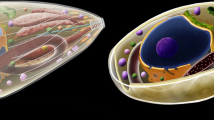Summary
The micorgametogony of T. gondii is investigated electronmicroscopically. The formation of the gametes begins with a multiplication of the gametocyte nucleus. The surface of the gametocyte develops many protuberances and a single cell nucleus migrates into each. Within the protuberances later to become the “perforatoria” of the microgamete, two flagella develop from each basal body. The protuberance then grows and buds off to form the microgamete. During this process the large mitochondrion migrates into closer contact with the nucleus. The nucleus elongates and when the last plasma connection is severed the microgamete lies free in the vacuole surrounding the parasite.
On the bases of the different structures observed, we suppose that the microgametes of T. gondii develop in groups, one after the other, in contrast to other Coccidia, e.g. E. pragensis, E. nieschulzi, E. perforans where they develop simultaneously. In T. gondii a residual body remains and, because of the form of the nucleus, the microgamete is wide and flat. The mitochondrion is of the tubular type; the tubules ramifying rather than lying in rows. Next to the two flagella rudimentary remains of a third can be found. In the perforatorium 16 or more very short microtubuli lie packed together on top of a strongly osmophilic plate but their function has not yet been determined.
Zusammenfassung
Die Ausbildung der Mikrogameten bei T. gondii beginnt mit einer Vervielfachung des Gamontenzellkerns. In der Oberfläche des Gamonten treten nacheinander mehrere Vorwölbungen auf, denen sich jeweils ein Zellkern zuordnet. In den Vorwölbungen bilden sich die späteren Perforatorien der Mikrogameten aus, und es werden— ausgehend von je einem Basalkörper — 2 Geißeln gebildet. Der Mikrogamet wächst jetzt gleichsam aus der Oberfläche des Gamonten heraus. Hierbei tritt das große Mitochondrium in engen Kontakt mit dem Zellkern. Der Zellkern streckt sich, und nach Durchtrennung einer letzten Plasmaverbindung liegen die Mikrogameten frei in der parasitophoren Vakuole.
Aufgrund verschiedener Bilder sind wir der Auffassung, daß die Mikrogameten von T. gondii — im Gegensatz zu denen anderer Coccidienarten (z. B. E. pragensis, E. nieschulzi, E. perforans) — nicht gleichzeitig, sondern in Gruppen nacheinander entstehen. Es bleibt ein Restkörper zurück. Der Mikrogamet von T. gondii ist, durch die Gestalt des Zellkerns verursacht, sehr breit und stark abgeflacht. Das Mitochondrium ist vom tubulären Typ; die Tubuli liegen nicht in Reihen, sondern ungeordnet im Mitochondrium. Neben den 2 Geißeln lassen sich Reste einer rudimentären dritten erkennen. Im Perforatorium sind 16 oder mehr sehr kurze Mikrotubuli in einer Reihe, dicht oberhalb einer stark osmiophilen Platte angelegt. Ihre Funktion ist zur Zeit noch nicht geklärt.
Similar content being viewed by others
Literatur
Cheissin, E. M.: Electron microscopic study of microgametogenesis in two species of Coccidia from rabbit (Eimeria magna and E. intestinalis). Acta protozool. 3, 215–224 (1965).
Colley, F.: Fine structure of microgametocytes and macrogametocytes of Eimeria nieschulzi. J. Protozool. 14, 663–674 (1967).
Zaman, V.: Observations on the endogenous stages of Toxoplasma gondii in the cat ileum. II. Electron microscope study. Southeast Asia J. Trop. Med. Publ. Hlth 1, 465–480 (1970).
Frenkel, J. K., Dubey, J. P., Miller, N. L.: Toxoplasma gondii in cats: Fecal stages identified as coccidian oocysts. Science 167, 893–896 (1970a).
Toxoplasma gondii: A coccidian of cats, with a wide range of mammalian and avian intermediate hosts. J. Parasitol. 56, No 4, Section II., 107, No 194 (1970b).
Hammond, D. M., Scholtyseck, E., Chobotar, B.: Fine structural study of the microgametogenesis of Eimeria auburnensis. Z. Parasitenk. 33, 65–84 (1969).
Miner, M. L.: The fine structure of microgametocytes of Eimeria perforans, E. stieda, E. bovis and E. auburnensis. J. Parasitol. 53, 235–247 (1967).
Hutchison, W. M., Dunachie, J. F., Siim, J. Chr., Work, K.: Coccidian-like nature of Toxoplasma gondii. Brit. med. J. 1970, I 142–144.
McLaren, D. J.: Observations on the fine structural changes associated with schizogony and gametogony in Eimeria tenella. Parasitology 59, 563–574 (1969).
Piekarski, G., Pelster, B., Witte, H. M.: Endopolygenie bei Toxoplasma gondii. Z. Parasitenk. 36, 122–130 (1971).
: Die Rolle der Katze in der Epidemiologie der Toxoplasmose. Kleintier-Prax. 14, 121–124 (1970).
Experimentelle und histologische Studien zur Toxoplasma-Infektion der Hauskatze. Z. Parasitenk. 36, 95–121 (1971).
Scholtyseck, E.: Die Mikrogametenentwicklung von Eimeria perforans. Z. Zellforsch. 66, 625–642 (1965).
Senaud, J., Cerna, Z.: La microgametogenese chez Eimeria pragensis (Černa et Senaud 1969) Sporozoa, Telosporea, Coccidia, Eimeriina, parasite de l'intestine de la souris: Etude du microscope electronique. Protistologica 6, 5–19 (1970).
Sheffield, H. G.: Schizogony in Toxoplasma gondii: an electron microscope study. Proc. helminth. Soc. Wash. 37, 237–242 (1970).
Weiland, G., Kühn, D.: Experimentelle Toxoplasma-Infektion bei der Katze. II. Entwicklungsstadien des Parasiten im Darm. Berl. Münch. tierärztl. Wschr. 7, 128–132 (1970).
Witte, H. M., Piekarski, G.: Die Oocysten-Ausscheidung bei experimentell infizierten Katzen in Abhängigkeit vom Toxoplasma-Stamm. Z. Parasitenk. 33, 358–360 (1970).
Author information
Authors and Affiliations
Rights and permissions
About this article
Cite this article
Pelster, B., Piekarski, G. Elektronenmikroskopische Analyse der Mikrogametenentwicklung bei Toxoplasma gondii . Z. F. Parasitenkunde 37, 267–277 (1971). https://doi.org/10.1007/BF00259333
Received:
Issue Date:
DOI: https://doi.org/10.1007/BF00259333




